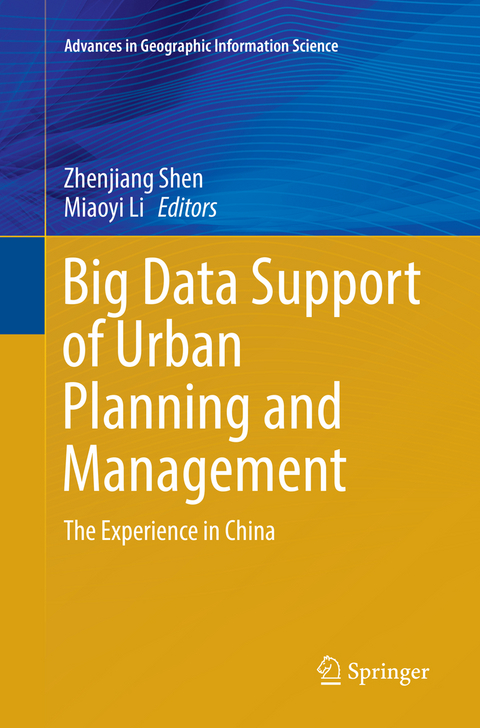
Big Data Support of Urban Planning and Management
Springer International Publishing (Verlag)
978-3-319-84780-1 (ISBN)
Zhenjiang Shen's research interests include policy-making support systems for planning and design using GIS & VR technology. He is serving as commissioner of Information Technology Education of Architectural Institute of Japan, and is a member of Scientific Committee of City Planning Institute of Japan. Dr. Shen also served as vice director, Urban Big data Commission, Chinese Society of Urban Studies. He is a member of Commission on Geospatial Analysis and Modeling of International Cartographic Association (ICA), and works as a joint member of Fudan University and PhD Instructor in Tsinghua University, China. Dr. Shen is editor-in-chief of IRSPSD International, managing editor of IJSSS and IJSSoc, and is General Director of International Community on Spatial Planning and Sustainable Development. Miayoyi Li's research interests include spatial/urban planning, urban big data analysis, Geospatial analysis & Geo-simulations. He served as a researcher in the Information Center of Tsinghua Tongheng Planning & Design Institute (THUPDI), which is affiliated with the School of Architecture, Tsinghua University.
Chapter 1: Overview: Big Data Support for Urban Planning and Management in China.- Part 1: Social Big Data for Exploring Human Behaviors and Urban Structure.- Chapter 2: Early Warning of Human Crowds Based on Query Data from Baidu Map: A Lesson from Shanghai Stampede.- Chapter 3: Research on Spatial Distribution Characteristics of Residents' Emotions Based on Sina Weibo Big Data: A Case Study of Nanjing.- Chapter 4: Measuring by Movements: Hierarchical Clustering of Cities in China Based on Aggregated Massive Positioning Data.- Chapter 5: Assessment of Regional Economic Integration Based on Relational Data: The Case of the Yangtze River Delta.- Chapter 6: The Recognition of CAZ in Shanghai Based on Evaluated POI.- Chapter 7: The Fear of Ebola: A Tale of Two Cities in China.- Part 2: POI for Exploring Urban Space Recognition.- Chapter 8: Identifying and Evaluating Urban Centers for the Whole China Using Open Data.- Chapter 9: Geographic Big Data's Applications in Retailing Business Market.- Chapter 10: Redefinition the Social Space Based on Social Atlas Analysis: A Case Study of Dongguan, China.- Chapter 11: The Spatial and Temporal Evolution of Innovative Function of Science and Technology of Beijing Based on the Analysis of Enterprise Data.- Part 3: Mobile Device Data for Integrating Land Use and Transportation Planning.- Chapter 12: Spatial Development Analysis of the Southern Area of Beijing Based on Multi-Source Data.- Chapter 13: Study on Population Dynamics and Mobility of Shanghai Based on Cell Phone Signaling Data.- Chapter 14: The Application of Big Data in the Study of Urban Spatial Structure.- Chapter 15: Application of Cellular Data in Traffic Planning.- Chapter16: Extract the Spatial-temporal Distribution of Transit Trips from Smart Card Transaction Data: A Comparison between Shanghai and Singapore.- Part 4: Cyber Infrastructure for Urban Management.- Chapter 17: Traffic Big Data and Its Application in Road Traffic Performance Evaluation-Illustrated bythe Case of Shenzhen.- Chapter 18: Understanding Job-Housing Relationship from Cell Phone Data Based on Hadoop.- Chapter 19: Towards Mobility Turn in Urban Planning: Smart Travel Planning Based on Space-Time Behavior in Beijing, China.- Chapter 20: Observing and Quantifying Vitality of Dashilanr: An Automatic Human Activity Data Collection Experiment.- Chapter 21: Urban wind path planning based on meteorological and remote sensing data and GIS based ventilation analysis.- Chapter 22: A Synthesized Urban Science in the Context of Big Data and Cyber infrastructure.
| Erscheinungsdatum | 10.12.2018 |
|---|---|
| Reihe/Serie | Advances in Geographic Information Science |
| Zusatzinfo | XXX, 456 p. 254 illus., 232 illus. in color. |
| Verlagsort | Cham |
| Sprache | englisch |
| Maße | 155 x 235 mm |
| Gewicht | 741 g |
| Themenwelt | Naturwissenschaften ► Biologie ► Ökologie / Naturschutz |
| Technik ► Elektrotechnik / Energietechnik | |
| Schlagworte | baidu • Bayesian Network • Big Data • Data Management • Ecological Space Recognition • Geocomputing • Landscape/Regional and Urban Planning • Origin Destination Flow • Rail Network • Regional Planning • Smart City • Social Media Data • social network service • Traffic Planning • urban planning • Urban Structure • Urban transport • Water Policy |
| ISBN-10 | 3-319-84780-5 / 3319847805 |
| ISBN-13 | 978-3-319-84780-1 / 9783319847801 |
| Zustand | Neuware |
| Haben Sie eine Frage zum Produkt? |
aus dem Bereich


